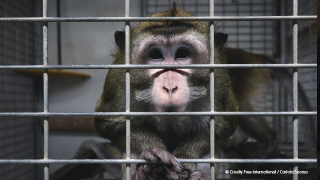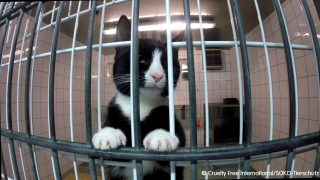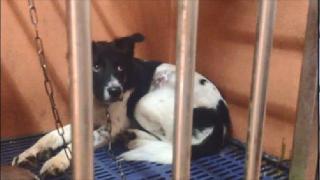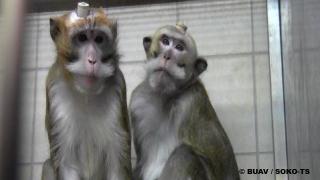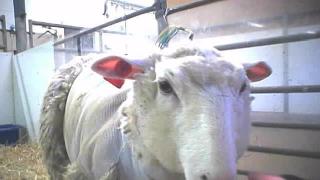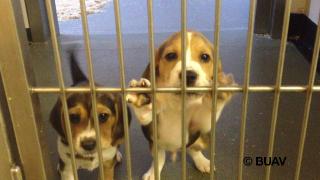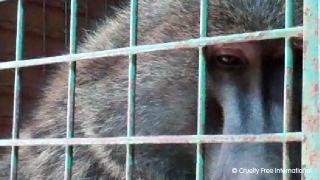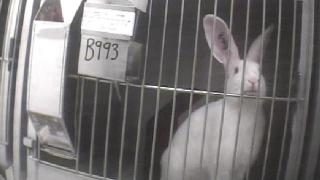An introduction to animal experiments
What are animal experiments?
An animal test is any scientific experiment or test in which a live animal is forced to undergo something that is likely to cause them pain, suffering, distress or lasting harm.
Animal experiments are not the same as taking your companion animal to the vet. Animals used in laboratories are deliberately harmed, not for their own good, and are usually killed at the end of the experiment.
Animal experiments include:
- injecting or force feeding animals with potentially harmful substances
- surgically removing animals’ organs or tissues to deliberately cause damage
- forcing animals to inhale toxic gases
- subjecting animals to frightening situations to create anxiety and depression.
Some experiments require the animal to die as part of the test. For example, regulatory tests for botox, vaccines and some tests for chemical safety are essentially variations of the cruel Lethal Dose 50 test in which 50% of the animals die or are killed just before the point of death.
Which animals are used?
A surprisingly, large range of animal species are regularly used in experiments, including wild animals.
Only vertebrate animals (mammals, birds, fish and amphibians) and some invertebrates such as octopuses are defined as “animals” by European legislation governing animal experiments. Shockingly, in the USA rats, mice, fish, amphibians and birds are not defined as animals under animal experiment regulations. That means no legal permission to experiment on them is needed and they are not included in any statistics.
Animals used in experiments are usually bred for this purpose by the laboratory or in breeding facilities. It’s a cruel, multi-million dollar industry. We believe that all animals are equally important. A dog bred for research is still a dog who could otherwise live a happy life in a loving home.
Some monkeys are still trapped in the wild in Africa, Asia and South America to be used in experiments or imprisoned in breeding facilities. Their children are exported to laboratories around the world. The use of wild-caught monkeys in experiments is generally banned in Europe but is allowed elsewhere.
Horses and other animals such as cows, sheep and pigs are often supplied by dealers and may originate from racing stables or farms for use in animal experiments. The rules preventing the use of stray companion animals like dogs and cats vary from country to country.
Wild animals can be used in trapping and monitoring experiments in the wild, or they may be captured and brought into a laboratory setting for more invasive research, sometimes in the name of conservation.
What are laboratories like?
Laboratories are no place for any animal. They are typically sterile, indoor environments in which the animals are forced to live in cages, pens or Perspex boxes – denied complete freedom of movement and control over their lives. Some animals in laboratories are confined on their own, without the companionship of others.
Our investigations show time and time again that, despite claims by the animal research community, life inside a laboratory is no life at all.
The science relating to animal experiments can be extremely complicated and views often differ. What appears on this website represents Cruelty Free International expert opinion, based on a thorough assessment of the evidence.
Investigations
Toxicity testing on animals at Vivotecnia, Spain
subtitle: Breaking investigation once again reveals shocking cruelty and abuse faced by animals in European laboratory
Toxicity testing at LPT, Germany
subtitle: Undercover video footage reveals terrible plight of animals at Laboratory of Pharmacology and Toxicology
Veterinary schools using dogs, Japan
subtitle: Exposed: Appalling suffering at a UK animal testing laboratory
Investigation at Khon Kaen University, Thailand
subtitle: Street dogs are being used in student veterinary classes
Monkey experiments at Max Planck Institute, Germany
subtitle: Our investigation uncovers the horror of life for monkeys in a top European animal experiments laboratory
Dog and cat experiments at MSD Animal Health, United Kingdom
subtitle: A Cruelty Free International investigation in 2013 uncovered the shocking use of very young puppies and kittens in animal experiments in a UK laboratory.
Experiments on wild baboons in Kenya
subtitle: Our investigation exposes the cruel use of wild baboons in for animal experiments
Animal experiments at Imperial College London, United Kingdom
subtitle: We uncovered the terrible plight of animals used in research at this ‘world-leading’ UK university.
Animal experiments at Wickham Laboratories, United Kingdom
subtitle: Exposed: Appalling suffering at a UK animal testing laboratory

